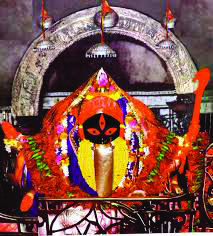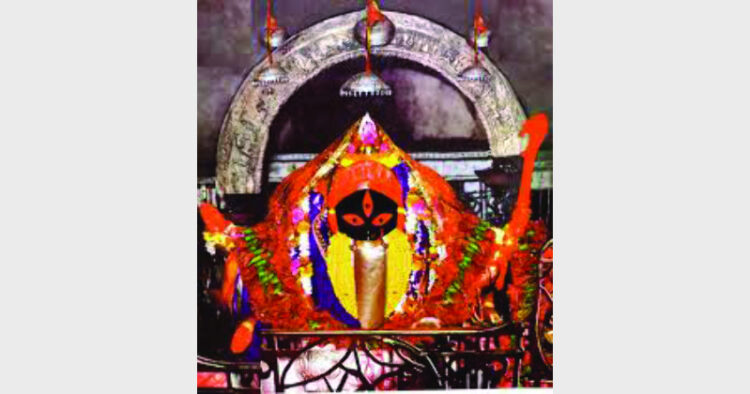Temples of West Bengal
 West Bengal has diverse cultural and religious history; this is evident from the temples and other monuments that adorn the city and its suburb.
West Bengal has diverse cultural and religious history; this is evident from the temples and other monuments that adorn the city and its suburb.
Dakshineshwar Kali Temple built in 1855, in an area of 25 acres, at Dakshineshwar located in the outskirts of Kolkata. The temple is dedicated to Goddess Kali, and this has close associations with Ramakrishna Paramahansa who attained nirvana at this holy temple only. The temple is situated on the sacred banks of the Ganges, which is considered holy. There is a story related with the temple, legend has it that Rani Rashmoni built this temple, who was blessed with a divine dream about building a Kali Temple. There is still the room where Sri Ramakrishna Paramahansa used to live, and everything including the bed on which he used to take rest still exist
Baidyanatha Temple devoted to Lord Shiva is situated on the north western side of West Bengal. It is a pilgrim spot and it is located about 200 miles from Kolkata. Baidyanatha is marked in the maps as Deogurh.
The shrine of Baidyanatha is said to have its origin to a Santhal. The Baidyanatha Temple has the figures of four bulls in the right of the doorway. These four bulls represent the Nandi, the vahana or vehicle of Lord Shiva. All these four bulls at Baidyanatha are of different sizes but none of them are as large as a calf. The emblem of the deity in the Baidyanatha Temple is situated in the innermost sanctum, which is dark amid the blaze of noon. A lamp can be seen in front of the deity, which burns day and night, fed with ghee. A little stone can be seen under its light. It is Baidyanatha himself that stands manifest and greets the eye.
Pareshnath Jain Temple This Jain Temple in Kolkata is located in the north-east side of the city, at the bustling Badridas Temple Street. The temple serves as an important worshipping place for the Jain community in Kolkata and also for others.
The temple is dedicated to Pareshnath, who was the 23rd Jain Tirthankar, and he is worshipped by the Jains, and this is one of the most important Jain temples in Kolkata. The deity of Lord Shitalnathji is seated in the sanctum sanctorum, and his diamond-studded forehead is a major attraction for the visitors. There is a lamp, which burns with ghee inside the sanctum sanctorum, which has been continuously burning ever since the initiation of the temple since 1867.
Kalighat Kali Temple A renowned place of pilgrimage for thousand devotees, Kalighat Kali Temple in Kolkata is one of the 51 Shakti Peethas. Once upon a time river Hooghly meandered by the holy shrine. However, with time, it is believed that the river drifted away from the Kalighat Kali Temple. In the recent times the temple is situated at the banks of Adi Ganga.
The Kali Temple at Kalighat in Kolkata is about 200 years old. The idol of Goddess Kali in the temple is quite different from the other idols in the State. At Kalighat Temple, the Goddess is portrayed with three huge eyes, a protruding tongue and four hands. Two of these hands hold severed human heads and a sword. The other two hands of the Goddess are in the varada and abhaya mudras. This signifies that the Goddess will bless those who pray to her with honesty and dedication and she will guide them in the right path forever. As per popular belief these severed heads represent the human ego which needs to be slain in order to achieve divine knowledge and finally, moksha. The sword in the hand of the Goddess implies divine knowledge.
Belur Math established by Swami Vivekananda is located on the banks of the River Ganges in Kolkata. The temple exhibits a fine style of architecture that combines the elements from a church, a mosque and a temple. Swami Vivekananda, who was a religious reformer, was among the first disciples of Ramakrishna Paramahansa to set this up as the headquarters of the Ramakrishna Mission and Math. The Ramakrishna Mission has been set up all over the world, and Belur Math is their headquarters.
Belur Math comprises a temple of Ramakrishna Paramahansa, which is separated by a transparent glass cover. There is an old temple where Ramakrishna Paramahansa is regularly worshipped. The temple of Ramakrishna took a period of 4 years to be built and was funded by an American disciple of Swami Vivekananda named Ms. Hellen Rubel. Besides this there is Swami Vivekananda’s room located adjacent to the old temple, a temple dedicated to Holy Mother, Sarada Devi, the two storied temple of Swami Vivekananda, the “Samadhi Peetha”, the temple of Swami Brahmananda and the Ramakrishna Museum.
Ananta Basudeba Temple is a temple of Lord Krishna in the Hangseshwari Temple Complex in Banshberia, in the Hooghly District of West Bengal. Built by Raja Rameswar Datta in 1679, this temple is noted for the exquisite terracotta works on its walls. The terracota works depict stories from the great Indian epics Ramayana and Mahabharata, as well as from lilas of Krishna.
Attahas Temple also known as Fullora Attahas, is believed to be one of the 52 Shakti Peethas at which the body parts and jewellery of the Hindu Goddess Shakti fell to Earth. The Goddess is so large that the lower lip is about 15 to 18 feet wide. The temple is located in the Nirolgram panchayat in the Katwa subdivision of the Bardhaman district of West Bengal.
Birla Mandir in Kolkata, is a Hindu temple on Asutosh Chowdhury Avenue,Ballygunge, built by the industrialist Birla family. The main temple houses statues of deities Lord Krishna and Radha. The left side temple shikhar (dome) houses Goddess Durga, the Hindu Goddess of Shakti, the power. The right side dome of the temple houses Shiva in meditation mode.
Hanseswari Temple is a Hindu Temple of Goddess Kali in the town of Banshberia at Hooghly district of West Bengal. The Hanseswari Temple has a distinctive architecture different from the usual pattern present in this area, consisting 13 minars or ratnas, each built as a blooming lotus bud. The inner structure of the building resembles human anatomy.It was started by Raja Nrisingha Deb Mahasay and later completed by his widow wife Rani Sankari.
Jagannath Temple is one of the ancient temples in Mohanpur in the Midnapore district of West Bengal. Idols of Jagannath, Balaram and Subhadra are present in the temple. This temple was constructed around 1611 by Karmahapatra family and is currently in a ruined condition and requires preservation. Legend is that the Puri Jagannath Mandir is visible from the peak of this temple.
Taraknath Temple dedicated to the Hindu God Shiva worshipped as Taraknath, is a major pilgrimage spot in the town of Tarakeswar, West Bengal. Built in 1729, the temple is an atchala structure of Bengal temple architecture with a natmandir in front. Close by are the shrines of Kali and Lakshmi Narayan. Dudhpukur, a tank to the north of the Shiva temple is believed to fulfil the prayers of those taking a dip in it
Chandaneshwar Located some 8 km from Digha, Chandaneshwar is famous for the Shiva Temple. The temple receives some half million pilgrims during Gajan Mela or Maha Vishuva Sankranti at the end of Chaitra.
Dhirdham Temple is a Hindu temple dedicated to Shiva. Situated below the Toy Train Railway Station in Darjeeling, this temple was built by Purna Bahadur Pradhan, the king of Nepal, in 1939. It has a white coloured statue of Lord Shiva facing the temple near its entrance. This statue depicts five different facial expressions in different moods with the universal third eye.
—Aniket Raja
(With inputes from West Bengal tourism)














Comments